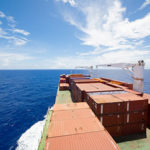A new report from UMAS, Getting to Zero Coalition, and Race to Zero finds that while it is possible for scalable zero-emission fuels to make up 5% of international shipping fuels by 2030 – shipping’s breakthrough target – the window of opportunity will close soon and rapid action is required from the industry.
The report, “Climate Action in Shipping, Progress towards Shipping’s 2030 Breakthrough,” paints a mixed picture when it comes to shipping’s core challenges of sourcing zero-emission fuels and deploying zero-emission vessels. Zero-emission fuel production currently in the pipeline could end up covering just a quarter of the fuel needed to deliver the breakthrough. However, if more projects are successful, zero-emission fuel production could be up to twice as much as is needed, even when accounting for other sectors’ fuel needs. On vessels, the picture is less rosy. Despite headline-grabbing orders for methanol-fuelled ships, continuing the current trajectory of orders might only deliver one-fifth of the needed vessels to achieve the breakthrough target.
“The last 12 months have seen a positive shift in maritime decarbonisation efforts. Now is the time to see strong progress in terms of commitment for zero carbon fuels and freight from the industry so that the needed rapid scale-up of these fuels in the energy mix is achieved,” says Dr Domagoj Baresic, Research Associate at UCL and Consultant at UMAS, and lead author of the report.
Progress on policy is critical to enabling the needed scale-up of supply and demand. Major progress has been achieved with the adoption of an ambitious greenhouse gas (GHG) emissions reduction strategy by the International Maritime Organization (IMO), which will be followed in 2025 by the adoption of concrete global measures to achieve the strategy’s goals. Because these measures are to be implemented after 2027, industry and national governments will need to make concerted, immediate efforts (e.g. through green corridors and national policy) to stimulate supply and demand in the intervening period and ensure that the industry is prepared to deliver on the IMO strategy before 2030.
“With the revision of the IMO’s greenhouse gas strategy, the industry’s direction of travel is clear. Especially in these early years, we need to be able to assess how fast we’re moving in that direction. This report shows that the industry is progressing, but that action still needs to accelerate,’’ says Jesse Fahnestock, Project Director at the Global Maritime Forum.
Launched in conjunction with the Global Maritime Forum’s Annual Summit in Athens, the report assesses progress towards the goal of having scalable zero-emission fuels account for 5% of international shipping fuels by 2030. This is the threshold needed to rapidly scale the uptake of such fuels and achieve full decarbonisation by at least 2050. Notably, the recently revised IMO strategy includes a new level of ambition and sets an important target of at least 5% – striving for 10% – uptake of zero or near-zero GHG emission fuels by 2030.
The report marks a significant milestone on the road to COP28 later this year in Dubai, providing a stocktake of progress. It evaluates the shipping breakthrough goal against five key levers for change: technology and supply; finance; policy; demand; and civil society action.
“The IMO has led with ambition and now the maritime sector is ready to cut emissions and boost green growth, particularly for developing nations. Dominant trading nations have a monumental opportunity to regain our stalled climate momentum by scaling the efforts that leading vessel owners, operators and shipping manufacturers have already begun. These urgent actions are also very important to protect nature and our oceans, unlocking a myriad of benefits for coastal communities across the globe,” says H.E. Razan Al Mubarak, UN Climate High-Level Champion for COP28.
The report indicates that financing for achieving the breakthrough is partially on track, with the amount of shipping finance covered by the Poseidon Principles surpassing US$200 billion and the climate alignment of these investments improving from 4% to 6% on a weighted average basis. The ability of the industry to continue to improve alignment as requirements tighten remains to be seen.
“Now that we know the international direction of travel for the maritime sector, the 175 member states need to create incentives for businesses and investors to implement zero-emission ships and freight services. Although there is progress towards its 2030 breakthrough target – for zero-emission fuels to make up 5% of international shipping’s energy demand by 2030 – we need to see policy makers create incentives for scaling up, for example, green hydrogen. The alignment of advances in technological innovation, supportive policies, and collaboration across the value chain, while recognising the differing challenges that developing countries face and the need for means of implementation, will be key for successfully moving towards a healthier, more resilient, zero-carbon world,” says Dr. Mahmoud Mohieldin, UN Climate Change High-Level Champion for COP27.
Source: Hellenic Shipping News





